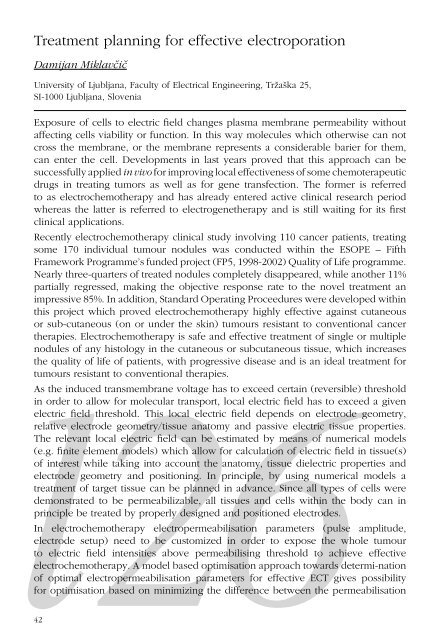Create successful ePaper yourself
Turn your PDF publications into a flip-book with our unique Google optimized e-Paper software.
Treatment planning for effective electroporation<br />
Damijan Miklav~i~<br />
University of Ljubljana, Faculty of Electrical Engineering, Tr`a{ka 25,<br />
SI-1000 Ljubljana, Slovenia<br />
Exposure of cells to electric field changes plasma membrane permeability without<br />
affecting cells viability or function. In this way molecules which otherwise can not<br />
cross the membrane, or the membrane represents a considerable barier for them,<br />
can enter the cell. Developments in last years proved that this approach can be<br />
successfully applied in vivo for improving local effectiveness of some chemoterapeutic<br />
drugs in treating tumors as well as for gene transfection. The former is referred<br />
to as electrochemotherapy and has already entered active clinical research period<br />
whereas the latter is referred to electrogenetherapy and is still waiting for its first<br />
clinical applications.<br />
Recently electrochemotherapy clinical study involving 110 cancer patients, treating<br />
some 170 individual tumour nodules was conducted within the ESOPE – Fifth<br />
Framework Programme’s funded project (FP5, 1998-20<strong>02</strong>) Quality of Life programme.<br />
Nearly three-quarters of treated nodules completely disappeared, while another 11%<br />
partially regressed, making the objective response rate to the novel treatment an<br />
impressive 85%. In addition, Standard Operating Proceedures were developed within<br />
this project which proved electrochemotherapy highly effective against cutaneous<br />
or sub-cutaneous (on or under the skin) tumours resistant to conventional cancer<br />
therapies. Electrochemotherapy is safe and effective treatment of single or multiple<br />
nodules of any histology in the cutaneous or subcutaneous tissue, which increases<br />
the quality of life of patients, with progressive disease and is an ideal treatment for<br />
tumours resistant to conventional therapies.<br />
42l26<br />
As the induced transmembrane voltage has to exceed certain (reversible) threshold<br />
in order to allow for molecular transport, local electric field has to exceed a given<br />
electric field threshold. This local electric field depends on electrode geometry,<br />
relative electrode geometry/tissue anatomy and passive electric tissue properties.<br />
The relevant local electric field can be estimated by means of numerical models<br />
(e.g. finite element models) which allow for calculation of electric field in tissue(s)<br />
of interest while taking into account the anatomy, tissue dielectric properties and<br />
electrode geometry and positioning. In principle, by using numerical models a<br />
treatment of target tissue can be planned in advance. Since all types of cells were<br />
demonstrated to be permeabilizable, all tissues and cells within the body can in<br />
principle be treated by properly designed and positioned electrodes.<br />
In electrochemotherapy electropermeabilisation parameters (pulse amplitude,<br />
electrode setup) need to be customized in order to expose the whole tumour<br />
to electric field intensities above permeabilising threshold to achieve effective<br />
electrochemotherapy. A model based optimisation approach towards determi-nation<br />
of optimal electropermeabilisation parameters for effective ECT gives possibility<br />
for optimisation based on minimizing the difference between the permeabilisation
















